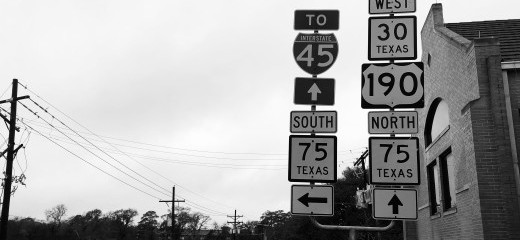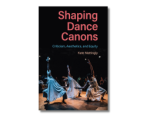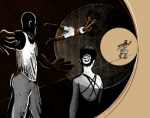
Out of Range
by Jennifer Passios
I started my MFA because I was sad, angry, and not dancing all that much — clearly, all great reasons to pursue an advanced degree.
A year prior to my first day of school, I moved to Huntsville, TX so my partner could begin his graduate studies. In doing so, I broke one of the cardinal rules I laid down for myself in my god-I-hope-I-get-it-agressively-pursuing-my-dreams-at-all-costs early 20s: that I would never, ever, move anywhere for a boy, ESPECIALLY to a town that most people couldn’t locate on a map.
This time, I made the concession happily on the naive assumption that, since my partner is a dancer and was finding opportunities to dance in and around a micropolitan most widely known for its robust prison system, I would too. The hope was well founded, but misplaced. Proximity to dance matters significantly when finding opportunities to work and perform professionally. Proximity isn’t much of a thing in Texas.
I was born and raised in Massachusetts where everything is proximal to approximately everything else. A one to four-hour ride by car, train, or bus — all readily accessible — can take a traveler from my hometown to Boston; New York City; Providence, RI; Portland, ME; New Hampshire’s White Mountains; countless beaches; and the Canadian border with relative ease. In contrast, a four-hour drive in Texas can take you to more Texas. An additional four-hour drive in Texas can take you to even more Texas. Much of that Texas consists of grass, windmills, cows, and the smell of oil. It can be beautiful, but a good old kick ball change can be hard to come by.
To dance requires access to reliable transit. When I first arrived in Huntsville, I figured I would spend most of my time galavanting around Houston, the nearest city with a professional dance presence. I severely miscalculated the resources necessary to make the regular sojourn 70 miles down I-45 — the second ugliest highway in the United States after the Jersey Turnpike — to access professional classes, company auditions, or performance spaces. I showed up with a 2006 Subaru, 275,000 miles and about eight recent major repairs deep. Although I was getting progressively more jumpy about driving anywhere, I was also becoming particularly skilled at knowing which parts of the car would make which noises before they sputtered, fell off, or started smoking and smelling like maple syrup.
Houston has almost no public transit, even within the city limits. Further North, in my area, there are no trains, and Uber requests get canceled regularly after 30 minutes without a driver available or willing to pick up the rideshare request. There is a bus. That bus is notoriously unreliable. To illustrate, one of my friends recently bought a ticket for said bus. He showed up to the bus station 20 minutes early. The bus driver, who didn’t feel like waiting around to pick up passengers, had already left. The next bus wasn’t scheduled to depart for six hours.
The total cost of carting myself back and forth to Houston quickly zapped my spirits and my bank account. Between the price of gas, the cost of class, the car repairs, and the minimum five-hour commitment to dance for 90 minutes, I found myself in a resource deficit that left me in desperate need of a lifeline. Initially, I landed a few job subbing at studios, but even those temporary positions required at least an hour and a half round trip in the car. I said yes, please. My car said no thank you.
I resigned myself to a COVID-era dance scenario – setting up YouTube on my apartment countertop, forcing my broom to moonlight as a barre, and attempting to frappe without getting chewed on too vigorously by my cat. The class material was fine. Dancing alone and doom-scrolling through images of my friends securing residencies, moving together, and posting their students’ triumphs made me want to chuck a vase at the wall. I tried to smile through it — moving was my own choice — but I only succeeded in clenching my jaw as I mourned. My friends were in a different time zone. My dancing was more whole-body crying than anything presentable. I was angry about the classes I couldn’t take, pissed at Texas for being too big and too spread out and too full of grass, and resentful of my partner, who took off at 9 every morning and came back at 10 p.m. after a full day of dance immersion.
Only select dancers who live in towns like mine are afforded the right to dance at a high level locally. Transportation, time, lack of art spaces, economic disenfranchisement, funding deficits, and other scarcity challenges loom large. Even if dance experiences were more readily available, a significant portion of my neighbors would likely need to opt out of attending in favor of securing a few extra hours at work, paying for child care, or obtaining groceries since over 28% of the local community lives below the poverty line. The counterbalance between Huntsville’s two staple industries – knowledge (the university) and incarceration (the prison system) – render our town both deeply in need of movement and inexorably bound by stasis.
When peers and students ask me why I came to graduate school, I often chuckle and say that it was an accident, that I started my MFA because I was sick of sitting in my house being sad. This approach, of course, minimizes the grief, but also reveals an important subtext. As in many small towns, the university here has been situated as a core survival mechanism. Still, access remains limited. Four to six dancers per year gain admittance to the MFA program where my partner and I currently study. I was able to secure one of those spots BECAUSE I came equipped with resources from my past dance experiences in places where, even living below the poverty line, I was able to take classes, teach students, meet choreographers (including two of my current professors), and add very sexy-looking things to my resume.
My past luck with proximity afforded me a chance to dance in Texas. I am grateful every day for the accumulation of those experiences but realize that my story could have been quite different had my past access to mentors, training, performance opportunities, friends, and connections been restricted by my geography.
Now, Monday through Friday, I stand in a well-lit studio while the prison whistle blows for evening headcount in the distance.
I gaze out the window, stretch my legs, and wonder what can be done to keep dancers from falling silently through the cracks.
—------------
Out of Range is the first installment in a multi-part series exploring the ability to access dance outside of major metropolitan areas. Part 2, Crazy Wood and Bare Feet can be found here
By Jennifer Passios
January 24, 2024






.png)


